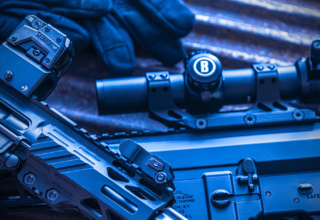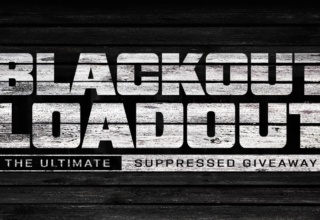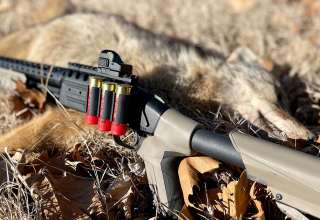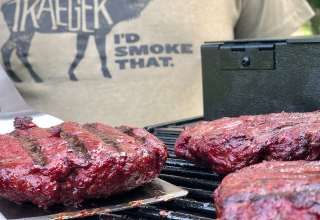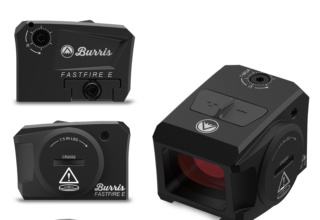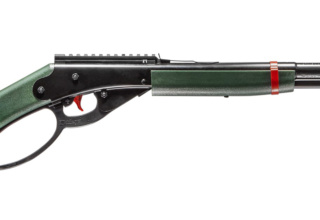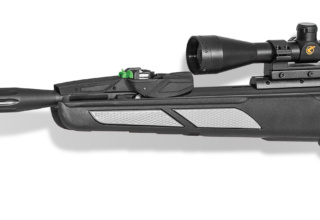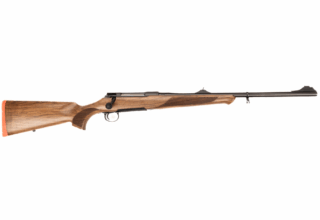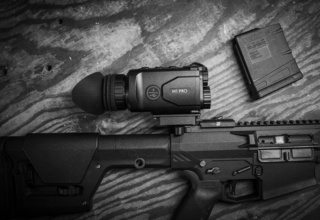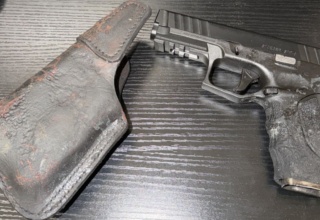Following a short phone conversation with a concerned farmer, plans were made to travel to a goat farm in southern Missouri to try to help take control of a coyote problem that the farmers herd had been facing. He explained to me during our phone call that over the past month the coyotes had taken several kid goats and had been regularly following the herd in search of their next meal. The farmer informed me that he had witnessed several coyotes in the area, and he specifically mentioned a larger coyote that had become brave enough to be seen amongst the herd during daylight hours, even when the local farmer was nearby. After expressing his concern of losing more goats, the farmer wanted to know if I could come as quickly as possible to try to help assist in controlling the coyote problem.
As a rule of thumb, even though summertime is one of my favorite times to hunt coyotes, I prefer hunting only when the early morning temperatures are below 70 degrees. This seems to be a setting point as to when calling coyotes has been the most successful for me. If it is over 70 degrees within the first few minutes of sunrise, I have found that coyote movement is not as good, plus the overall comfort level as a hunter decreases as well. The past week prior to the farmer calling the lows had been in the low 70’s and the highs in the mid 90’s, not exactly the ideal conditions that I prefer to hunt.
 However, with this situation I knew that something needed to be done quickly to help save the farmers livestock. The original plan was to hunt on a Thursday evening when the predicted high temperature was 96 degrees, but upon hearing the weather forecast on Wednesday evening, my attention turned to the upcoming weekend as the weatherman talked of a cool front arriving with lows in lower 60’s. I knew this had to be a sign from God to wait until the weekend. With the forecast in mind, plans were changed and I was now to meet up with the farmer early Sunday morning.
However, with this situation I knew that something needed to be done quickly to help save the farmers livestock. The original plan was to hunt on a Thursday evening when the predicted high temperature was 96 degrees, but upon hearing the weather forecast on Wednesday evening, my attention turned to the upcoming weekend as the weatherman talked of a cool front arriving with lows in lower 60’s. I knew this had to be a sign from God to wait until the weekend. With the forecast in mind, plans were changed and I was now to meet up with the farmer early Sunday morning.
Early that Sunday morning I awakened early enough to be able to drive 40 minutes to the farmers home, still arriving before sunrise. As I pulled into the drive, I was met by the farmer who was eager to show me a quick layout of the land, followed by the places in which he had encountered the most coyotes. After running a quick game plan through my head, based off of wind direction and ease of getting to a good location to call, I headed down a brushy fence line that would lead to a high vantage point which was perfect for trying to call for one of these hungry coyotes. For this particular hunt, I was excited to be carrying a Rock River Arms LAR-15 Fred Eichler Series Predator 2 chambered in a .223. I knew by talking to the landowner prior to hunting that I would be hunting in open pasture areas, a perfect scenario to be able to make possible long shots or make multiple follow up shots if necessary. In land layouts such as this, it is a perfect choice to hunt with an AR 15.
After finding a large tree that I could rest in front of and still be able to see into a small wooded area that the farmer had said he had witnessed multiple coyotes in, as well as see a large open pasture to my left, I quietly set out my FoxPro Shockwave electronic caller with an attached decoy. I set the decoy/caller combo approximately 15 yards in front of me with one speaker pointed into the timber and the other out into the open pasture. I began my calling sequence with a Female Lone Howl from the caller followed by 2 or 3 howls from my diaphragm call. After a minute and a half of silence after the howls I began playing Kid Goat Cries. This time I let the sound play for approximately 3 minutes, then immediately switched the sound to a Coyote Pup Distress sound. Once this particular sound had been playing for a mere 10 seconds, I caught movement of a coyote approaching from a slight angle behind, causing me to not see the coyote until he was just a mere 10 yards to the left of me. With my Rock River Arms .223 attached to the Swagger Bipod I was well rested, however pointed into the timber instead of towards the coyotes direction. The coyote was locked in on the spinning decoy. I elected to try turning my gun slowly in his direction. I almost had it turned enough to make the shot when he caught my movement and sprinted out into the open pasture.
 Once the coyote spooked, I continued moving my gun, hurrying to get it set to make a shot. The coyote made it to a draw leaving out of the area without being able to see him. Once I thought it was game over, I saw the big male coyote appear out in the field at the end of the draw. Luckily I still had my diaphragm call in my mouth and was able to let out a howl. The howl got the attention of the coyote just long enough for me to make a successful shot that dropped him in his tracks. After making the harvest, I continued with Pup Distress sounds for another minute or two until my excitement level got the best of me. I had to see how big this southern Missouri coyote really was.
Once the coyote spooked, I continued moving my gun, hurrying to get it set to make a shot. The coyote made it to a draw leaving out of the area without being able to see him. Once I thought it was game over, I saw the big male coyote appear out in the field at the end of the draw. Luckily I still had my diaphragm call in my mouth and was able to let out a howl. The howl got the attention of the coyote just long enough for me to make a successful shot that dropped him in his tracks. After making the harvest, I continued with Pup Distress sounds for another minute or two until my excitement level got the best of me. I had to see how big this southern Missouri coyote really was.
After my excitement level was finally contained, I realized that there was a few factors that made this hunt a success. The first tactic that made this hunt a success was knowing that there was coyotes in the area. In my opinion this is one of most important factors in successfully calling coyotes, usually I rely on scouting an area to figure out where coyotes are living. However, in this situation the farmer had done the job for me. He was able to show me exactly where he had encountered coyotes on a continuous basis and with that knowledge, I had no doubt that there was coyotes in the area. If one isn’t sure that there are coyotes in the area, DO NOT call it.
The second factor that played into this hunting success story is hunting the area when the conditions are right. Once I knew that the forecast of low 60’s was predicted, I knew that coyotes would be more active. Coyotes are the same as humans when it comes to activity during the summer months of the year. When it is hot, we stay in the shade and keep movement to a minimum to control body heat and the same goes for coyotes.
 The third part of this favorable plan was being prepared with good equipment. Being able to have an electronic caller with a good sound library allowed me to go in and create a territorial factor by doing multiple coyote vocals. I was then able to play sounds of a kid goat that I was positive coyotes in the area were familiar with due to the farmers unfortunate loss of multiple goats. A decoy attached to this call was also a key factor that kept the attention of the coyote long enough so that I was able to see the coyote and make adjustments to put myself into a position to make the shot with a weapon designed to be accurate enough to make long distance shots. My first hunt with the RRA .223 was a success for sure.
The third part of this favorable plan was being prepared with good equipment. Being able to have an electronic caller with a good sound library allowed me to go in and create a territorial factor by doing multiple coyote vocals. I was then able to play sounds of a kid goat that I was positive coyotes in the area were familiar with due to the farmers unfortunate loss of multiple goats. A decoy attached to this call was also a key factor that kept the attention of the coyote long enough so that I was able to see the coyote and make adjustments to put myself into a position to make the shot with a weapon designed to be accurate enough to make long distance shots. My first hunt with the RRA .223 was a success for sure.
Hunting coyotes during the summer months of the year can sometimes be frowned upon due to the fur not being good enough to harvest. Arguments are often raised as to why one would harvest an animal that can not be used for anything. My recent hunt is exactly why I began hunting in the summer, and that reason being is to help farmers and landowners, I use this time of year to help eliminate predators that are disturbing livestock such as sheep, goats and even cattle. As for wildlife management purposes, the summer months of the year are when the most damage is done to wildlife. This time of year is when fawns are still young enough to be easy prey, young turkeys, rabbits and even quail are no different. Hunting predators when prey is most vulnerable is something that more hunters, conservationist and landowners can do to become more successful at managing wildlife.



